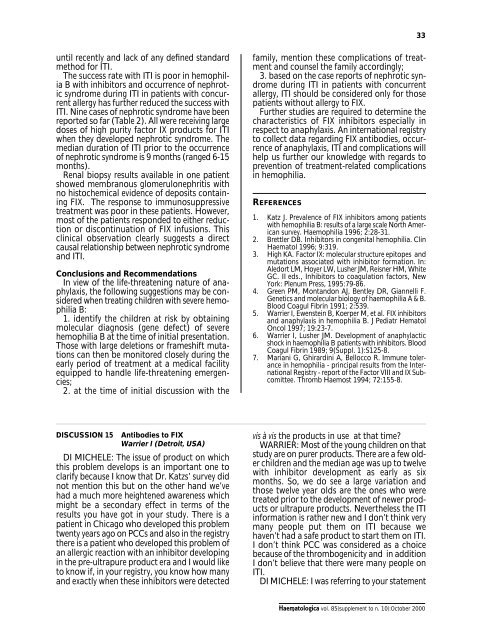Haematologica 2000;85:supplement to no. 10 - Supplements ...
Haematologica 2000;85:supplement to no. 10 - Supplements ...
Haematologica 2000;85:supplement to no. 10 - Supplements ...
You also want an ePaper? Increase the reach of your titles
YUMPU automatically turns print PDFs into web optimized ePapers that Google loves.
33<br />
until recently and lack of any defined standard<br />
method for ITI.<br />
The success rate with ITI is poor in hemophilia<br />
B with inhibi<strong>to</strong>rs and occurrence of nephrotic<br />
syndrome during ITI in patients with concurrent<br />
allergy has further reduced the success with<br />
ITI. Nine cases of nephrotic syndrome have been<br />
reported so far (Table 2). All were receiving large<br />
doses of high purity fac<strong>to</strong>r IX products for ITI<br />
when they developed nephrotic syndrome. The<br />
median duration of ITI prior <strong>to</strong> the occurrence<br />
of nephrotic syndrome is 9 months (ranged 6-15<br />
months).<br />
Renal biopsy results available in one patient<br />
showed membra<strong>no</strong>us glomerulonephritis with<br />
<strong>no</strong> his<strong>to</strong>chemical evidence of deposits containing<br />
FIX. The response <strong>to</strong> immu<strong>no</strong>suppressive<br />
treatment was poor in these patients. However,<br />
most of the patients responded <strong>to</strong> either reduction<br />
or discontinuation of FIX infusions. This<br />
clinical observation clearly suggests a direct<br />
causal relationship between nephrotic syndrome<br />
and ITI.<br />
Conclusions and Recommendations<br />
In view of the life-threatening nature of anaphylaxis,<br />
the following suggestions may be considered<br />
when treating children with severe hemophilia<br />
B:<br />
1. identify the children at risk by obtaining<br />
molecular diag<strong>no</strong>sis (gene defect) of severe<br />
hemophilia B at the time of initial presentation.<br />
Those with large deletions or frameshift mutations<br />
can then be moni<strong>to</strong>red closely during the<br />
early period of treatment at a medical facility<br />
equipped <strong>to</strong> handle life-threatening emergencies;<br />
2. at the time of initial discussion with the<br />
family, mention these complications of treatment<br />
and counsel the family accordingly;<br />
3. based on the case reports of nephrotic syndrome<br />
during ITI in patients with concurrent<br />
allergy, ITI should be considered only for those<br />
patients without allergy <strong>to</strong> FIX.<br />
Further studies are required <strong>to</strong> determine the<br />
characteristics of FIX inhibi<strong>to</strong>rs especially in<br />
respect <strong>to</strong> anaphylaxis. An international registry<br />
<strong>to</strong> collect data regarding FIX antibodies, occurrence<br />
of anaphylaxis, ITI and complications will<br />
help us further our k<strong>no</strong>wledge with regards <strong>to</strong><br />
prevention of treatment-related complications<br />
in hemophilia.<br />
REFERENCES<br />
1. Katz J. Prevalence of FIX inhibi<strong>to</strong>rs among patients<br />
with hemophilia B: results of a large scale North American<br />
survey. Haemophilia 1996; 2:28-31.<br />
2. Brettler DB. Inhibi<strong>to</strong>rs in congenital hemophilia. Clin<br />
Haema<strong>to</strong>l 1996; 9:319.<br />
3. High KA. Fac<strong>to</strong>r IX: molecular structure epi<strong>to</strong>pes and<br />
mutations associated with inhibi<strong>to</strong>r formation. In:<br />
Aledort LM, Hoyer LW, Lusher JM, Reisner HM, White<br />
GC. II eds., Inhibi<strong>to</strong>rs <strong>to</strong> coagulation fac<strong>to</strong>rs, New<br />
York: Plenum Press, 1995:79-86.<br />
4. Green PM, Montandon AJ, Bentley DR, Giannelli F.<br />
Genetics and molecular biology of haemophilia A & B.<br />
Blood Coagul Fibrin 1991; 2:539.<br />
5. Warrier I, Ewenstein B, Koerper M, et al. FIX inhibi<strong>to</strong>rs<br />
and anaphylaxis in hemophilia B. J Pediatr Hema<strong>to</strong>l<br />
Oncol 1997; 19:23-7.<br />
6. Warrier I, Lusher JM. Development of anaphylactic<br />
shock in haemophilia B patients with inhibi<strong>to</strong>rs. Blood<br />
Coagul Fibrin 1989; 9(Suppl. 1):S125-8.<br />
7. Mariani G, Ghirardini A, Bellocco R. Immune <strong>to</strong>lerance<br />
in hemophilia - principal results from the International<br />
Registry - report of the Fac<strong>to</strong>r VIII and IX Subcomittee.<br />
Thromb Haemost 1994; 72:155-8.<br />
DISCUSSION 15 Antibodies <strong>to</strong> FIX<br />
Warrier I (Detroit, USA)<br />
DI MICHELE: The issue of product on which<br />
this problem develops is an important one <strong>to</strong><br />
clarify because I k<strong>no</strong>w that Dr. Katzs’ survey did<br />
<strong>no</strong>t mention this but on the other hand we’ve<br />
had a much more heightened awareness which<br />
might be a secondary effect in terms of the<br />
results you have got in your study. There is a<br />
patient in Chicago who developed this problem<br />
twenty years ago on PCCs and also in the registry<br />
there is a patient who developed this problem of<br />
an allergic reaction with an inhibi<strong>to</strong>r developing<br />
in the pre-ultrapure product era and I would like<br />
<strong>to</strong> k<strong>no</strong>w if, in your registry, you k<strong>no</strong>w how many<br />
and exactly when these inhibi<strong>to</strong>rs were detected<br />
vis à vis the products in use at that time<br />
WARRIER: Most of the young children on that<br />
study are on purer products. There are a few older<br />
children and the median age was up <strong>to</strong> twelve<br />
with inhibi<strong>to</strong>r development as early as six<br />
months. So, we do see a large variation and<br />
those twelve year olds are the ones who were<br />
treated prior <strong>to</strong> the development of newer products<br />
or ultrapure products. Nevertheless the ITI<br />
information is rather new and I don’t think very<br />
many people put them on ITI because we<br />
haven’t had a safe product <strong>to</strong> start them on ITI.<br />
I don’t think PCC was considered as a choice<br />
because of the thrombogenicity and in addition<br />
I don’t believe that there were many people on<br />
ITI.<br />
DI MICHELE: I was referring <strong>to</strong> your statement<br />
<strong>Haema<strong>to</strong>logica</strong> vol. <strong>85</strong>(<strong>supplement</strong> <strong>to</strong> n. <strong>10</strong>):Oc<strong>to</strong>ber <strong>2000</strong>
















